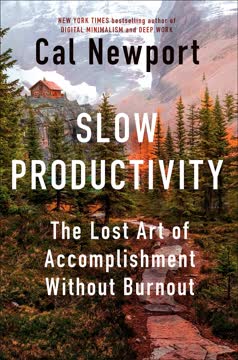Key Takeaways
1. Motivation is warped: Debunk common myths and focus on progress
Stuff gets warped.
Motivation misconceptions abound. Many popular beliefs about motivation, such as the power of positive thinking or the effectiveness of rewards, are either exaggerated or misunderstood. These myths can lead to ineffective strategies and disappointing results.
Focus on progress, not success. Instead of fixating on end goals or relying on inspirational speeches, concentrate on creating structures that support steady progress. This approach aligns with research showing that a sense of progress is the most powerful motivator in the workplace.
Debunk myths:
- Positive thinking alone doesn't lead to success
- Rewards can sometimes undermine intrinsic motivation
- Goal setting isn't always effective, especially for complex tasks
Emphasize progress: - Create visible markers of advancement
- Celebrate small wins
- Design work processes that provide frequent feedback
2. Change is hard but necessary: Embrace the challenge and discomfort
Reality is broken. Game designers can fix it.
Change is inevitable and essential. In today's rapidly evolving world, organizations and individuals must adapt to stay relevant and competitive. However, change often brings discomfort and resistance, which must be acknowledged and addressed.
Approach change like a game designer. By framing change initiatives as well-designed games, we can make the process more engaging and less daunting. This approach taps into our natural inclination to tackle challenges and seek progress within structured environments.
Characteristics of well-designed change:
- Clear objectives
- Manageable challenges
- Frequent feedback
- Visible progress markers
- Opportunities for mastery
Benefits of a game-like approach: - Increased engagement
- Reduced resistance
- Enhanced problem-solving
- Improved collaboration
3. The big motivation gap: Bridge the divide between current and desired states
All progress, growth and change lives within this gap.
Understand the motivation gap. The space between where we are and where we want to be is the breeding ground for motivation and progress. This gap creates constructive discontent, which can be harnessed to drive change.
Design bridges across the gap. To maintain motivation, we need to create structures that make the journey across the gap more manageable and rewarding. This involves breaking down large goals into smaller, achievable milestones and providing clear feedback along the way.
Elements of the motivation gap:
- Current state (where we are)
- Desired state (where we want to be)
- The journey between (process of change)
Strategies for bridging the gap: - Set proximal goals
- Create visible progress markers
- Provide frequent feedback
- Celebrate small wins
- Adjust challenges to maintain flow
4. The root of all game-changing hacks: Make progress visible
Make progress visible.
Visibility is key to motivation. When people can clearly see how their efforts contribute to progress, they are more likely to stay engaged and motivated. This principle applies to both individual tasks and organizational initiatives.
Design for progress visibility. Create systems and tools that make progress easy to track and understand. This can range from simple checklists to more complex project management software, but the key is to ensure that progress is consistently and clearly communicated.
Ways to make progress visible:
- Use progress bars or charts
- Implement regular check-ins or stand-up meetings
- Create public displays of project advancement
- Utilize digital tools for real-time progress tracking
Benefits of visible progress: - Increased motivation
- Better focus on important tasks
- Enhanced sense of accomplishment
- Improved team alignment
5. Get your head into the game: Understand the power of game design
Games are simply the interplay between goals, rules and feedback.
Games are more than just entertainment. The principles of game design can be applied to work and life to create more engaging and motivating experiences. Understanding these principles allows us to redesign our approaches to challenges and change.
Apply game design elements to work. By incorporating clear goals, well-defined rules, and frequent feedback into our work processes, we can create more engaging and productive environments. This approach taps into our natural inclination to seek progress and overcome challenges.
Key elements of game design:
- Goals: Clear objectives to strive for
- Rules: Constraints that shape behavior and strategy
- Feedback: Information about progress and performance
Benefits of gameful design at work: - Increased engagement
- Enhanced problem-solving
- Improved collaboration
- Greater resilience in the face of setbacks
6. The game changer model: Integrate goals, rules, and feedback
The game changer is that newly introduced element that makes a significant difference to the game in play.
Understand the game changer model. This framework integrates the key elements of motivation and game design to create more effective approaches to work and change. It provides a structured way to analyze and improve existing processes.
Apply the model to your challenges. By systematically examining and adjusting the goals, rules, and feedback in your work or change initiatives, you can identify opportunities for improvement and create more engaging, motivating experiences.
Components of the game changer model:
- Spark: The core goal or intent
- Action layer: Specific, actionable steps
- Project layer: Organization and sequencing of actions
- Game layer: Motivational design elements
- Game changer: Meta-level perspective for adjusting the game
Application process:
- Identify the current "game" (work process or change initiative)
- Analyze its components using the model
- Identify areas for improvement
- Implement changes and monitor results
7. Lift your game: Overcome self-sabotage and ask the right questions
We are profoundly adept at getting in our own way.
Recognize and address self-sabotage. Many of us unconsciously undermine our own progress through procrastination, perfectionism, or overcommitment. Identifying these patterns is the first step to overcoming them.
Ask the right questions to improve your game. By systematically examining your goals, rules, and feedback processes, you can identify areas for improvement and design better approaches to your challenges.
Common forms of self-sabotage:
- Procrastination
- Perfectionism
- Overcommitment
- "Too busy" for progress
- Environmental excuses
Key questions to ask: - Goals: Are they clear, meaningful, and appropriately challenging?
- Rules: Do they support progress and allow for autonomy?
- Feedback: Is progress visible and frequently communicated?
8. Change the game: Implement missions, quests, and rituals
If you do not change direction, you may end up where you are heading.
Design work as missions and quests. Framing work in terms of missions (clear objectives) and quests (exploratory challenges) can make it more engaging and meaningful. This approach provides both structure and flexibility.
Establish rituals to support change. Regular practices and routines can reinforce desired behaviors and create a sense of progress. These rituals can range from daily stand-up meetings to quarterly review sessions.
Characteristics of missions and quests:
- Missions: Clear objectives, defined pathways
- Quests: Exploratory challenges, emphasis on learning
Examples of effective rituals: - Daily stand-up meetings (7-12 minutes)
- Weekly progress reviews
- Quarterly project planning sessions
- Annual culture book creation (like Zappos)
Benefits of this approach: - Increased engagement
- Better alignment with organizational goals
- Enhanced adaptability to change
- Stronger team cohesion
Last updated:
FAQ
What's "The Game Changer" about?
- Purpose of the book: "The Game Changer" by Jason Fox explores how to use the science of motivation combined with game design principles to influence behavior, shape culture, and drive progress in organizations.
- Core concept: The book introduces the idea of changing the "game" at work by tweaking goals, rules, and feedback to enhance motivation and productivity.
- Target audience: It is aimed at leaders, managers, and anyone interested in improving motivation and engagement in their teams or organizations.
- Practical application: The book provides strategies and models to implement these concepts in real-world scenarios, making work more engaging and effective.
Why should I read "The Game Changer"?
- Innovative approach: The book offers a fresh perspective on motivation by integrating game design principles, which is not commonly found in traditional management literature.
- Evidence-based insights: It debunks common motivational myths and provides evidence-based strategies to enhance motivation and productivity.
- Practical tools: Readers gain access to practical tools and models that can be directly applied to improve workplace dynamics and culture.
- Broader impact: Understanding these concepts can lead to significant improvements in personal productivity and organizational success.
What are the key takeaways of "The Game Changer"?
- Progress principle: Making progress visible is crucial for sustaining motivation and engagement in any task or project.
- Game design elements: Goals, rules, and feedback are the core components of any game and can be applied to work to enhance motivation.
- Intrinsic motivation: Purpose, mastery, and autonomy are essential for fostering intrinsic motivation, which is more sustainable than extrinsic rewards.
- Iterative approach: Change and progress require a continuous process of experimentation and iteration, rather than one-time solutions.
How does Jason Fox define a "game changer"?
- Definition: A "game changer" is a newly introduced element or factor that significantly alters an existing situation or activity.
- Role in motivation: It involves changing the parameters of work to make it more engaging and motivating.
- Application: By identifying and implementing game-changing elements, organizations can shift behavior and culture effectively.
- Outcome: The goal is to create a work environment where progress and motivation are inherent, leading to better outcomes.
What is the "Progress Principle" in "The Game Changer"?
- Core idea: The Progress Principle states that a clear sense of progress is the most significant factor in motivating people at work.
- Feedback loops: Reducing the latency between effort and feedback enhances motivation by making progress visible.
- Practical application: Organizations should focus on creating structures that provide immediate and meaningful feedback to sustain motivation.
- Impact on work: When employees see how their efforts contribute to progress, they are more likely to remain engaged and motivated.
How does "The Game Changer" address self-sabotage?
- Common forms: The book identifies procrastination, perfectionism, and overcommitment as common forms of self-sabotage.
- Strategies to overcome: It suggests making progress visible, setting clear goals, and creating supportive structures to mitigate self-sabotage.
- Role of visibility: By enhancing the visibility of progress, individuals can better manage their time and focus on what truly matters.
- Behavioral change: The book emphasizes changing the game to alter behavior, rather than trying to change motivation directly.
What are the myths about games discussed in "The Game Changer"?
- Myth #1: Games are only for young people or those avoiding work. The book debunks this by showing that games are a universal and engaging form of work.
- Myth #2: People play games just to win. In reality, games are about mastering challenges and experiencing progress.
- Myth #3: Games are an escape from hard work. The book argues that well-designed games are challenging work that people willingly engage in.
- Broader understanding: By understanding these myths, readers can better appreciate the role of game design in motivation.
How does "The Game Changer" suggest using game design in work?
- Core elements: The book emphasizes using goals, rules, and feedback to structure work like a game.
- Purpose and mastery: Aligning work with purpose and mastery enhances intrinsic motivation.
- Iterative design: Work should be designed iteratively, allowing for continuous improvement and adaptation.
- Practical application: By applying these principles, organizations can create more engaging and motivating work environments.
What is the "Game Changer Model"?
- Components: The model includes layers of action, project, and game, each contributing to motivation and progress.
- Action layer: Focuses on translating goals into specific, actionable steps.
- Project layer: Organizes actions into coherent projects that align with broader goals.
- Game layer: Involves tweaking goals, rules, and feedback to enhance motivation and engagement.
How does "The Game Changer" propose to shift organizational culture?
- Behavioral focus: Culture change is achieved by influencing behaviors through motivation strategy and design.
- Structures and rituals: Establishing effective structures and rituals can reinforce desired behaviors and cultural norms.
- Iterative process: Culture change is an ongoing process that requires continuous experimentation and adaptation.
- Role of leadership: Leaders play a crucial role in shaping culture by modeling behaviors and setting the tone for change.
What are the best quotes from "The Game Changer" and what do they mean?
- "Make progress visible." This quote emphasizes the importance of feedback and visibility in sustaining motivation.
- "Success is simply a failure to fail." It highlights the iterative nature of progress and the value of learning from failure.
- "We are all 100 per cent motivated, even when we are not." This challenges the notion of motivation as a fixed trait and suggests that behavior is a result of the environment.
- "The house always wins." It underscores the idea that games are designed to favor their creators, and by understanding this, we can design better work environments.
How can I apply the concepts from "The Game Changer" in my organization?
- Start with visibility: Implement systems that make progress and feedback visible to all team members.
- Design for motivation: Use game design principles to structure work in a way that enhances intrinsic motivation.
- Iterate and adapt: Continuously experiment with new strategies and adapt based on feedback and results.
- Focus on culture: Use structures, rituals, and artifacts to shape and reinforce the desired organizational culture.
Review Summary
The Game Changer receives mixed reviews, with an average rating of 3.91/5. Many readers appreciate its innovative approach to motivation through game design principles, finding it insightful and practical. Some praise the author's writing style and the book's synthesis of organizational behavior concepts. However, critics argue it lacks practical implementation advice and relies too heavily on established theories. Some readers find the content repetitive or superficial, while others consider it a must-read for those interested in workplace motivation and gamification.
Similar Books









Download PDF
Download EPUB
.epub digital book format is ideal for reading ebooks on phones, tablets, and e-readers.




